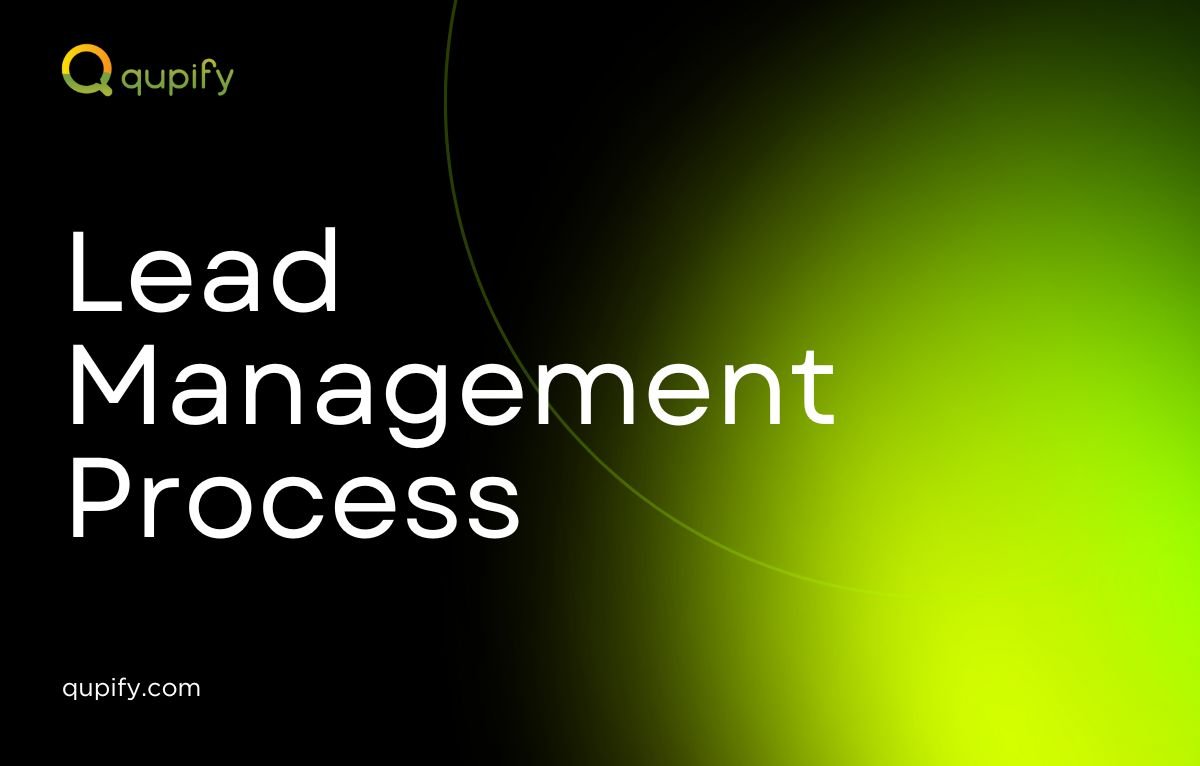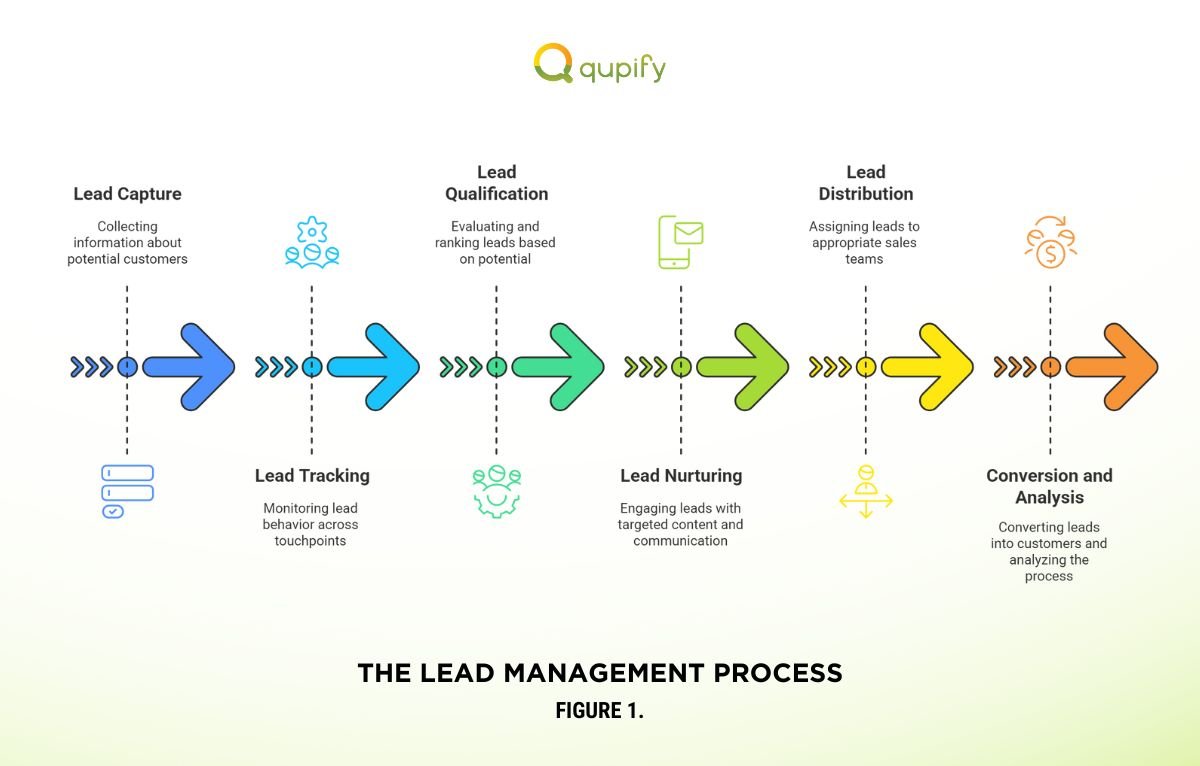The lead management process helps businesses systematically track, nurture, and convert potential customers into loyal buyers.
It provides clarity and structure, ensuring leads don’t fall through the cracks. A well-executed lead management process can boost sales efficiency and increase conversion rates by focusing on the right leads at the right time.
Below, we explore each stage of this process in detail.

Process | Description | Example Task |
Lead Capture | Collecting information about potential customers. | Setting up website forms to gather emails. |
Lead Tracking | Monitoring lead interactions and behavior. | Tracking website visits through CRM tools. |
Lead Qualification | Evaluating and prioritizing leads based on conversion potential. | Using lead scoring to rank prospects. |
Lead Nurturing | Building trust and keeping leads engaged until they are ready to buy. | Sending personalized email campaigns. |
Lead Distribution | Assigning leads to the appropriate sales teams or representatives. | Automating assignments by region. |
Conversion & Analysis | Closing sales and reviewing metrics to improve future processes. | Analyzing conversion rates for campaigns. |
Lead capture is the foundation of the lead management process. This step involves collecting information about potential customers, such as their names, email addresses, and purchasing intent.
Businesses typically capture leads through website forms, email subscriptions, social media ads, or events.
Effective lead capture ensures a steady stream of prospects for nurturing and conversion.
Tracking leads allows businesses to monitor their behavior and interactions across multiple touchpoints. This can include website visits, email engagement, or social media activity.
By leveraging tools like CRM software, businesses can gain insights into a lead’s preferences and readiness to purchase.
This data empowers sales teams to create personalized follow-ups and engagement strategies.
Not all leads have the same potential to convert. Lead qualification separates high-value prospects from those less likely to purchase.
Using criteria such as demographics, engagement, and budget, businesses can evaluate and rank leads. Lead scoring systems automate this process by assigning scores based on predefined metrics, helping sales teams prioritize their efforts effectively.
Lead nurturing focuses on building trust and keeping potential customers engaged over time. This involves sharing targeted content, offering solutions to their pain points, and maintaining consistent communication.
Channels like email marketing, educational webinars, and social media campaigns are often used for nurturing. The goal is to guide leads smoothly through the sales funnel until they are ready to convert.
In larger organizations, distributing leads to the appropriate sales representatives or teams is crucial. This step ensures that leads receive prompt and relevant attention.
Businesses often use automation tools to assign leads based on geographic region, industry expertise, or urgency. Streamlined lead distribution improves response times and increases the likelihood of conversion.
The final step in the lead management process is converting leads into customers and analyzing the process for future optimization.
Conversion involves closing the sale and ensuring customer satisfaction.
Post-conversion, businesses analyze metrics like lead response times, conversion rates, and campaign performance to identify strengths and weaknesses.
This continuous improvement cycle helps refine strategies and maximize efficiency.

Automation plays a crucial role in enhancing the efficiency of the lead management process. By automating tasks like lead capture, tracking, and scoring, businesses can save time and minimize human error.
Automated systems ensure every lead is logged and followed up on without delay, which is especially vital for large-scale operations.
For example, automating lead nurturing allows businesses to send personalized email campaigns at scale, keeping prospects engaged throughout their journey.
Similarly, automating lead distribution ensures that leads are assigned promptly to the right sales representatives, reducing response times and increasing the chances of conversion.
By incorporating automation into every stage of the process, businesses not only streamline operations but also create a seamless experience for their leads, ultimately driving better results with less effort.
GoHighLevel is a powerful tool for automating and managing the lead management process in retail businesses. It offers an all-in-one platform that simplifies tasks like lead capture, tracking, and nurturing.
With features like customizable CRM pipelines, automated email and SMS campaigns, and real-time analytics, GoHighLevel ensures that businesses can efficiently manage large volumes of leads.
One of its standout features is its automation capabilities, which enable businesses to set up workflows that handle follow-ups, lead scoring, and even lead distribution without manual intervention.
Additionally, GoHighLevel integrates with various platforms like websites, social media, and e-commerce tools, ensuring a seamless flow of data for better decision-making.
For retail businesses, GoHighLevel is particularly beneficial as it centralizes all lead management tasks, saving time, reducing errors, and improving the overall customer experience.
Qupify simplifies retail lead management through a range of automation tools and services designed to streamline critical tasks:
A well-structured lead management process allows businesses to efficiently handle leads at every stage of the sales funnel.
By capturing, tracking, qualifying, nurturing, and analyzing leads, companies can optimize their sales strategies and create better customer experiences.
Implementing these processes is key to staying competitive and maximizing revenue growth.